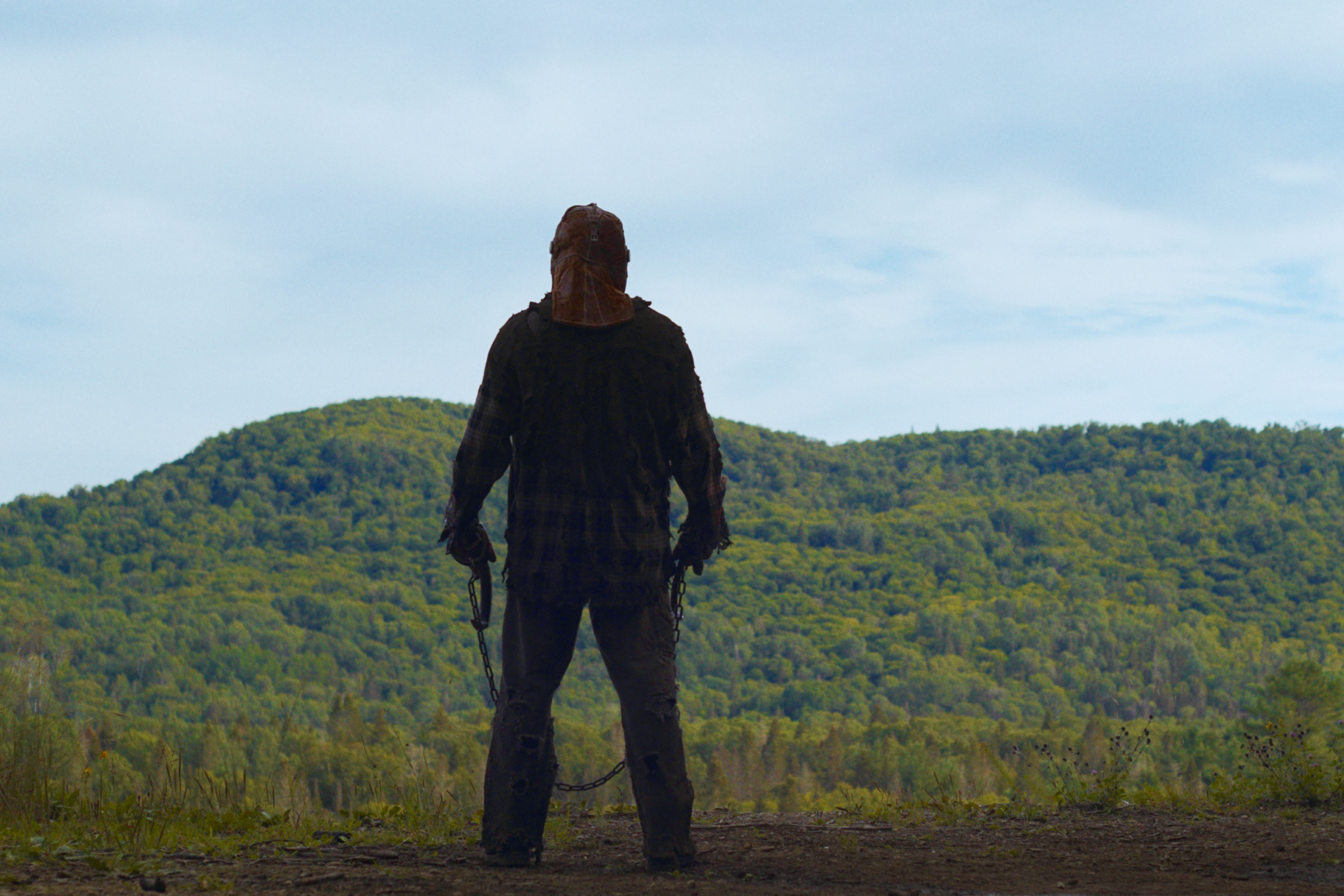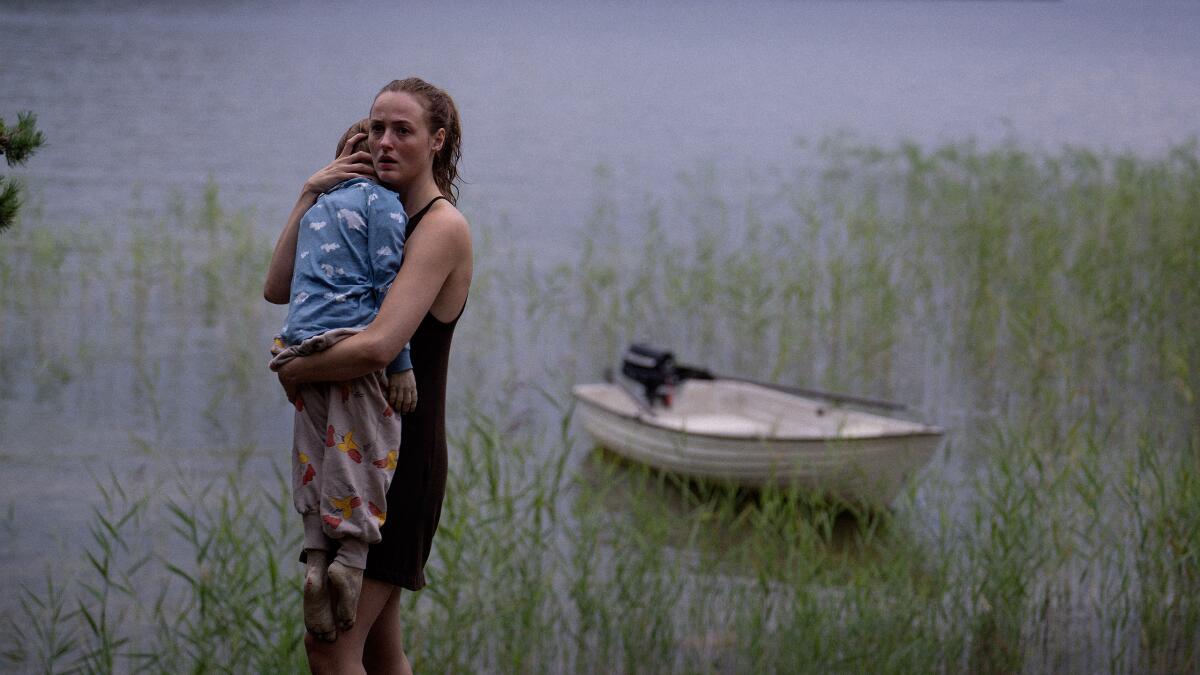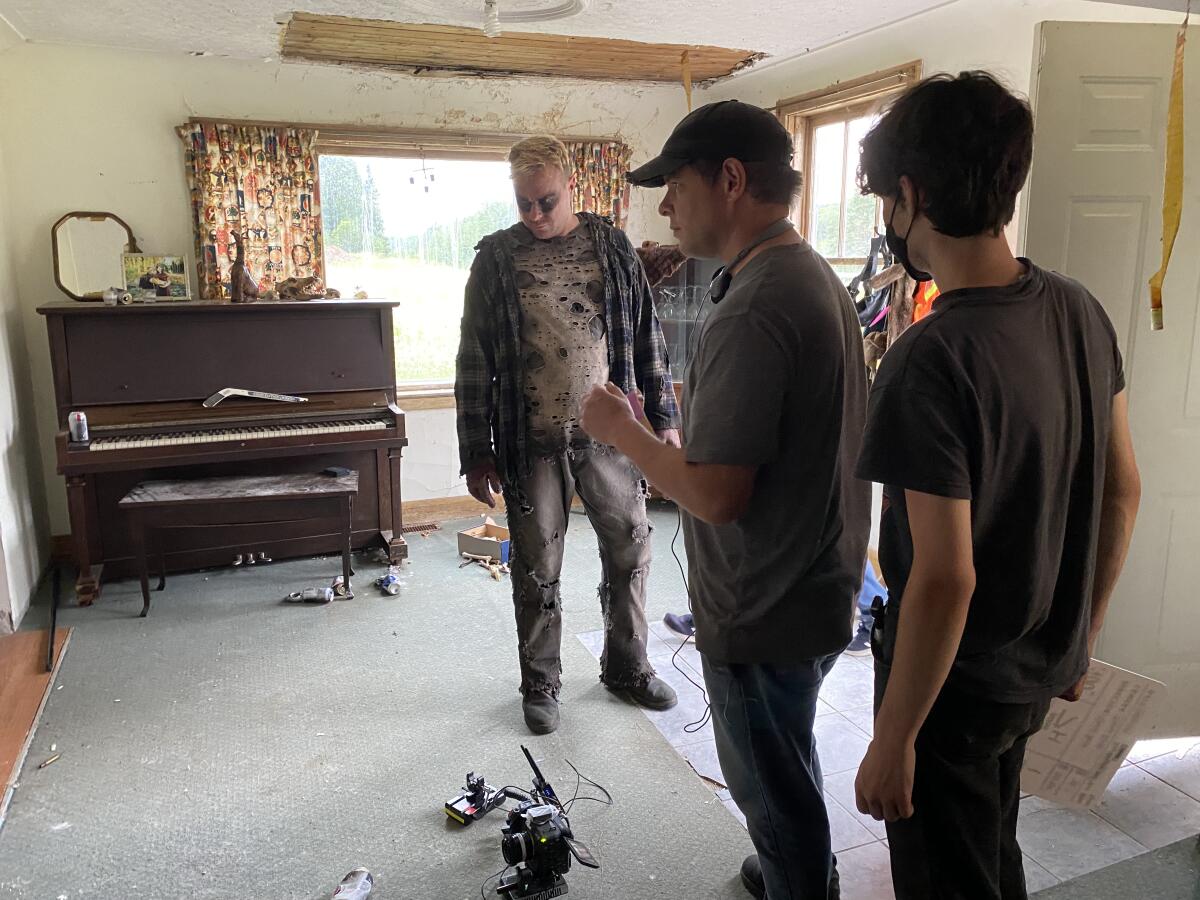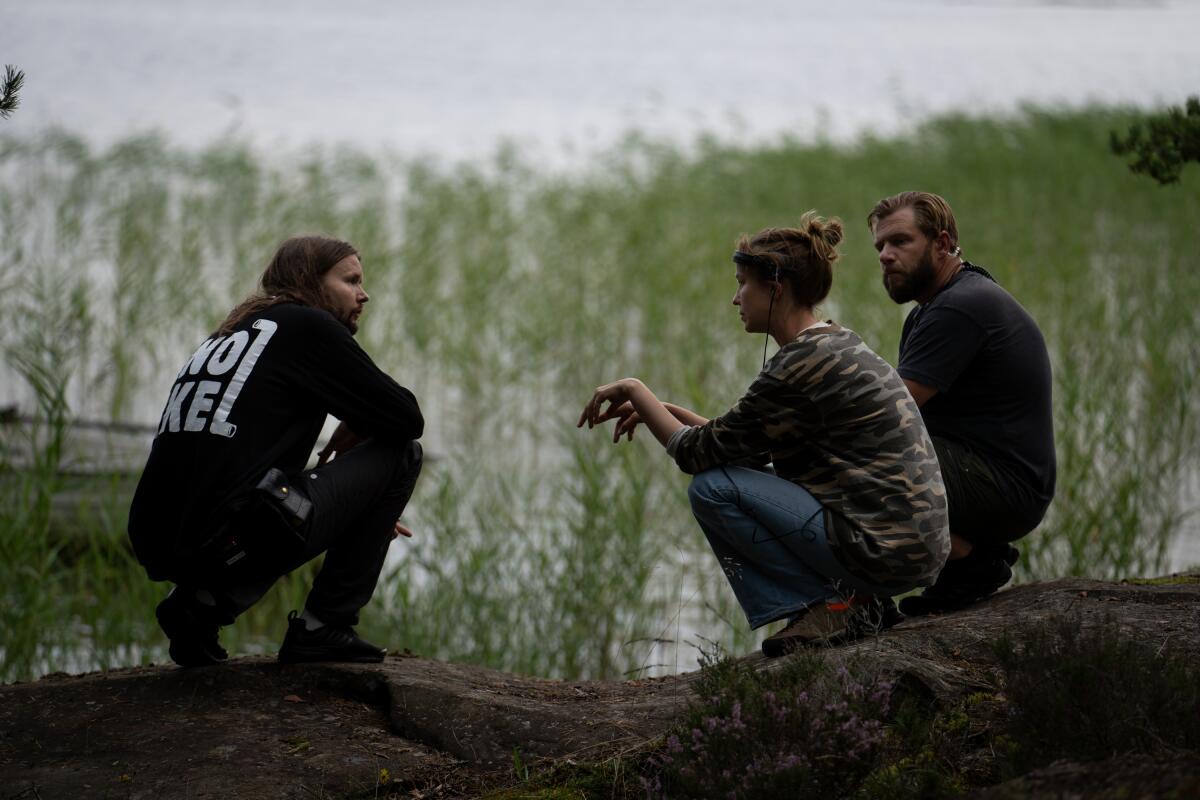Newsletter
Only good movies
Get the Indie Focus newsletter, Mark Olsen's weekly guide to the world of cinema.
You may occasionally receive promotional content from the Los Angeles Times.

A masked murderer trudges through the woods, Jason Voorhees-like, but instead of springing out at us like a surprise, we permanently stay by his side, a companion to his lonely blood-soaked quest for vengeance. A decomposing zombie boy returns home to his grieving mother and religious grandfather, but instead of screaming in terror, his relatives care for him with tenderness.
A pair of new horror films opening in Los Angeles over the next two weeks cleverly disrupt the tried-and-tested ways of their respective subgenres.
Told from the point of view of the killer, Canadian filmmaker Chris Nashâs feature debut âIn a Violent Natureâ is a slasher movie that patiently follows a mute, burly revenant named Johnny (Ry Barrett) from one kill to the next, as if in a first-person shooter game. Though he includes some gruesome showstoppers, Nash intentionally avoids a traditional catharsis.
The other one, âHandling the Undeadâ by Norwegian director Thea Hvistendahl, is a sorrowful, moody twist on the zombie film starring Renate Reinsve and Anders Danielsen Lie from âThe Worst Person in the World.â Here, the groggy undead arenât after peopleâs brains nor do they infect anyone else with a virus. They simply come back to their loved ones, confused. Grief-stricken, the living take care of these sentient corpses, hoping to find signs of who they once were.
The film staff saw much in Park City, Utah, during the 40th annual Sundance Film Festival. Here were our 10 top picks: stirring dramas and documentaries.
âItâs much less of a rollercoaster and more of a tour bus,â says Nash, 42, on a video call about âIn a Violent Nature.â Similarly, âHandling the Undeadâ is meditative in tone. Hvistendahl, 35, refers to it over Zoom as âa drama with a horror premiseâ and âa melancholic horror.â
They both exude an unassuming playfulness. And if you look through their filmmaking backgrounds, neither explains the thoughtful concepts that have emerged in their breakthroughs, both of which premiered at this yearâs Sundance Film Festival in January.
Nash grew up infatuated with the VHS cover art for horror titles and reading Fangoria magazine as he dabbled in amateur makeup effects. Hvistendahl, for her part, didnât envision a path in horror until she directed the 2019 short film âChildren of Satan,â actually about two girls at a Christian summer camp.
âI set out then to make a poetic thriller and when it was done, people called it a horror,â Hvistendahl says. âIt was when I was making that film that I found that I really enjoyed using genre in my films.â
Nash cites some unusual influences for a midnight moviemaker, primarily Gus Van Santâs methodical, early-2000s âdeath trilogyâ â âGerry,â âElephant,â and âLast Daysâ â respectively, about a pair of friends lost in a desert; a school shooting inspired by the incident at Columbine; and Kurt Cobainâs suicide. Those movies address tough subject matter with a stark pragmatism.
In all of them, the camera prowls behind the characters, a seemingly objective witness. Nash believes that, by doing so, Van Sant relinquishes ownership of the narratives, opening them up to interpretation.
âI liked the fact that I never felt pushed by him as a filmmaker,â says Nash. âI felt very much like I was being carried by the characters.â

The concept of a slasher in the wilderness was the ideal format for Nash to replicate that formula, affording long stretches of silence.
âThere is a slight documentary feel to it that fools you into feeling thereâs some authenticity to what youâre watching, even if itâs a zombie monster walking through the woods,â he says.
For Hvistendahl, her main source of inspiration was a book, âHandling the Undead,â the 2005 Swedish novel by John Ajvide Lindqvist, best known for writing the vampire drama âLet the Right One In.â
The singularity of Lindqvistâs universe â somehow both grounded and otherworldly â inspired the filmmaker to make her âChildren of Satan,â and when the rights for âHandling the Undeadâ became available, she jumped at them.
âWhat I really enjoy about a lot of his work,â the director says, âis how instead of treating it as purely supernatural, itâs treated a bit more like magical realism.â
Inheriting a screenplay by the author, Hvistendahl rewrote it, keeping its mournful essence but removing most of the bureaucratic elements detailing how the government, quite literally, handles the undead by isolating them in a housing complex.

To break the rules of their cinematic predecessors, both Nash and Hvistendahl devised new parameters to adhere to in the making of their projects.
In direct defiance of so many slashers of the past (all the way back to John Carpenterâs âHalloweenâ), Nash opted for no score and instead let environmental sounds take its place. Additionally, he tried to include Johnny in every shot, whether just his hand, a foot or a piece of his clothing.
âIt was important that Johnnyâs presence was felt in every frame until the pivotal moment in the climax,â Nash explains.
From Hvistendahlâs perspective, her most daunting concern was to avoid humor, despite the example of âShaun of the Deadâ and so many successful zom-coms. While doing her research, she realized that zombies could trigger laughs when attacking or moving fast â a no-no.
âFor the atmosphere that I wanted to create, where we have to care for the undead and understand how the living feel for them, I thought that making them funny would be taking the film to a different place,â Hvistendahl says, also elaborating on her reason to cut the novelâs sparing use of zombie dialogue. âIt would have been hard to have them talk without making them silly.â

Another challenge for Hvistendahl was to find the correct look for the undead. The intent was for them to appear unalive while still getting across a sense of the person they used to be.
âWe did a lot of research on dead people and what it looks like when they start to rot,â she adds. âBut those details are also very difficult to find because no one has really dug up a two-week-old body.â
Worried about the physicality of her undead, Hvistendahl worked with a movement coach who developed theories about bodily separation in the afterlife. Now back in their mortal bodies, zombies would move differently since they were used to walking through walls weightlessly.
Inconsistent on-screen movement was one of the key reasons Nash decided to reshoot his film from scratch after completing nearly 80% of principal photography during the fall of 2021 in Sault Ste. Marie, Canada, the directorâs hometown eight hours northwest of Toronto.
Within the first week of shooting, Nash had to recast the actor playing Johnny after the original performer had an unexpected medical issue. Upon receiving the assembly cut, the director noticed the subtle difference between the two actors he used to embody the monster.
âWith a character that doesnât speak, everything is about how he moves, so you pick up on all the minute differences between the two performances,â Nash says. âIt became really clear that, âOh, this isnât the same person.ââ
Modestly, Nash ultimately attributes his do-over to a lack of confidence and communication skills after mostly working in special effects and makeup for several years. âThe real reason it had to be shot twice was because it had been too long since I directed any bit of fictional narrative,â he admits. âI got way too rusty with being able to convey how I wanted something portrayed.â
In the end, the two movies feel like formal gambles that succeed in throwing the viewer off balance. For Nash, his contemplative approach to âIn a Violent Natureâ gives the audience space to thoughtfully consider what theyâre looking at, and why the artist would want to point their gaze there.
Hvistendahl was interested in articulating the human desire to hold on to those we love even after they are gone. Horror served as the vehicle to create a singular metaphor out of tropes most are familiar with.
âDeath is the one thing we as humans have yet to fully understand,â she says. âItâs so hard for the brain to understand that they will not come back.â
Movies like âFive Nights at Freddyâsâ and âM3ganâ proved the resilience of PG-13 horror movies at the box office. Another one, âImaginary,â is on deck.
Both filmmakers expect polarized reactions from audiences for their unconventional horror outings.
Hvistendahl knows hers is a tricky sell. âIf I say itâs a horror film to some people, theyâll say, âI donât want to see that,ââ she says. âFor others, if I say itâs horror, they are expecting more gore or jump scares.â
Nash believes there will be two audiences for âIn a Violent Nature.â The first is the one that is deeply familiar with the genre, made up of those who will appreciate that the story takes the killerâs point of view for a change.
âThereâs also going to be an audience that is expecting a very straightforward âFriday the 13thâ clone,â says Nash. âAnd I could see them being either pleasantly surprised or incredibly disappointed with the speed at which my movie runs. Hopefully everybody gives it a chance and either likes or dislikes it for the movie that it is and not the movie that it isnât.â
And no matter where you may fall along that spectrum, you canât fault him for trying something different.
âGenre is an open playground,â Nash notes. âItâs the one area of culture where there are no hard and fast rules. You can make a genre film that has zero scares in it, but itâs still a genre film and I find that immensely interesting.â
Heâs not talking about his own movie, though. âIn a Violent Natureâ isnât devoid of scares, nor is âHandling the Undead.â But both challenge the way weâve been conditioned to expect our shocks.
Watching them, we must surrender to their uniquely unnerving pace â as good a definition of horror as any.
Only good movies
Get the Indie Focus newsletter, Mark Olsen's weekly guide to the world of cinema.
You may occasionally receive promotional content from the Los Angeles Times.